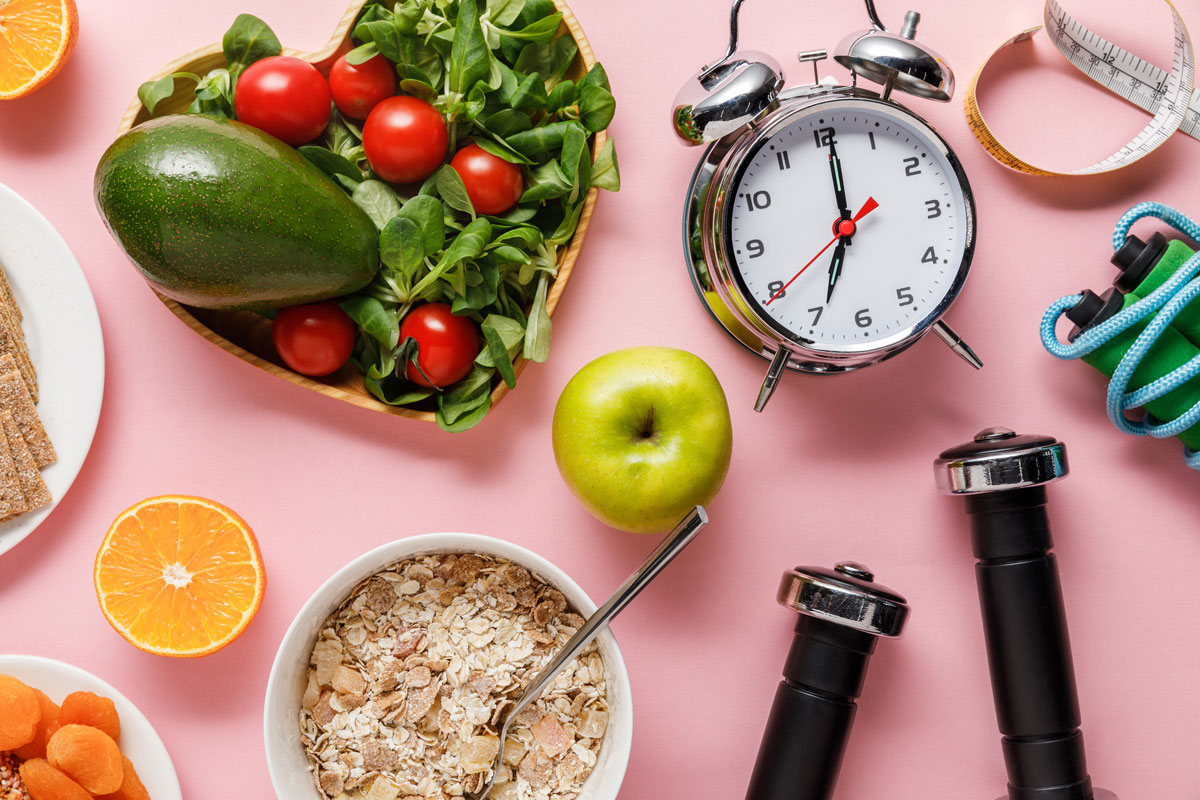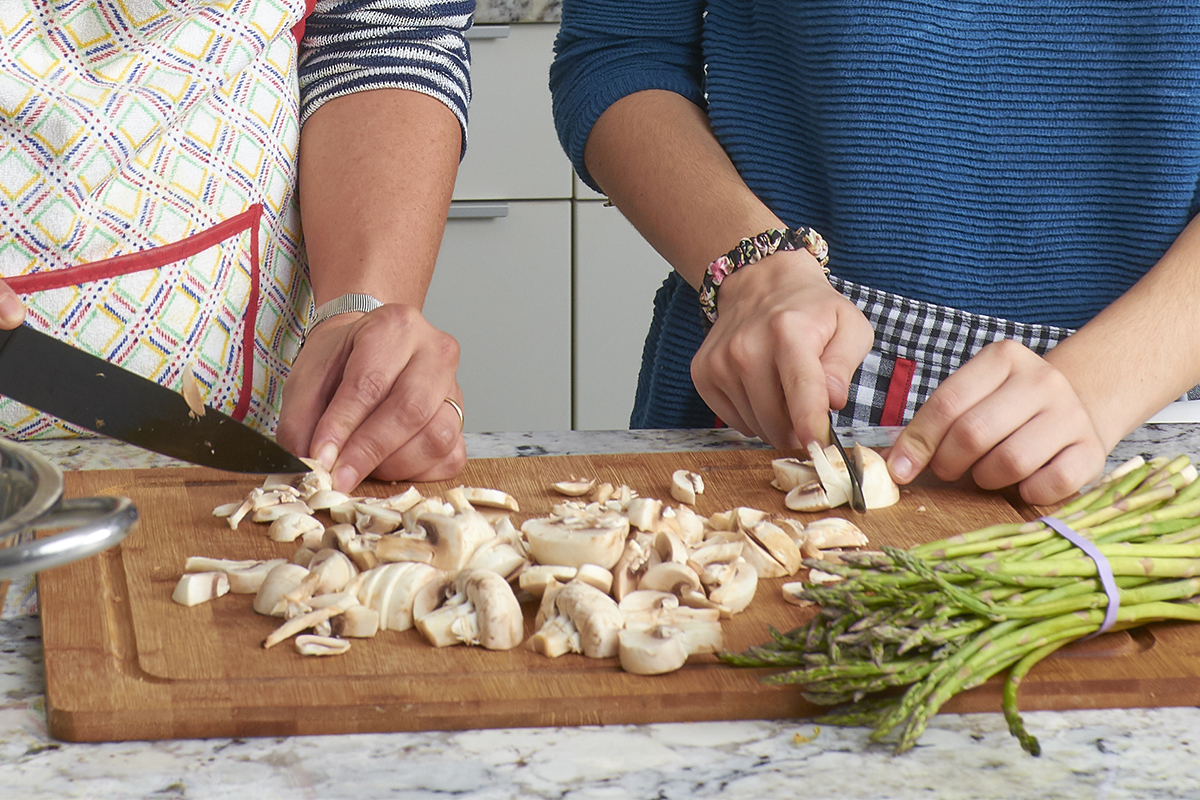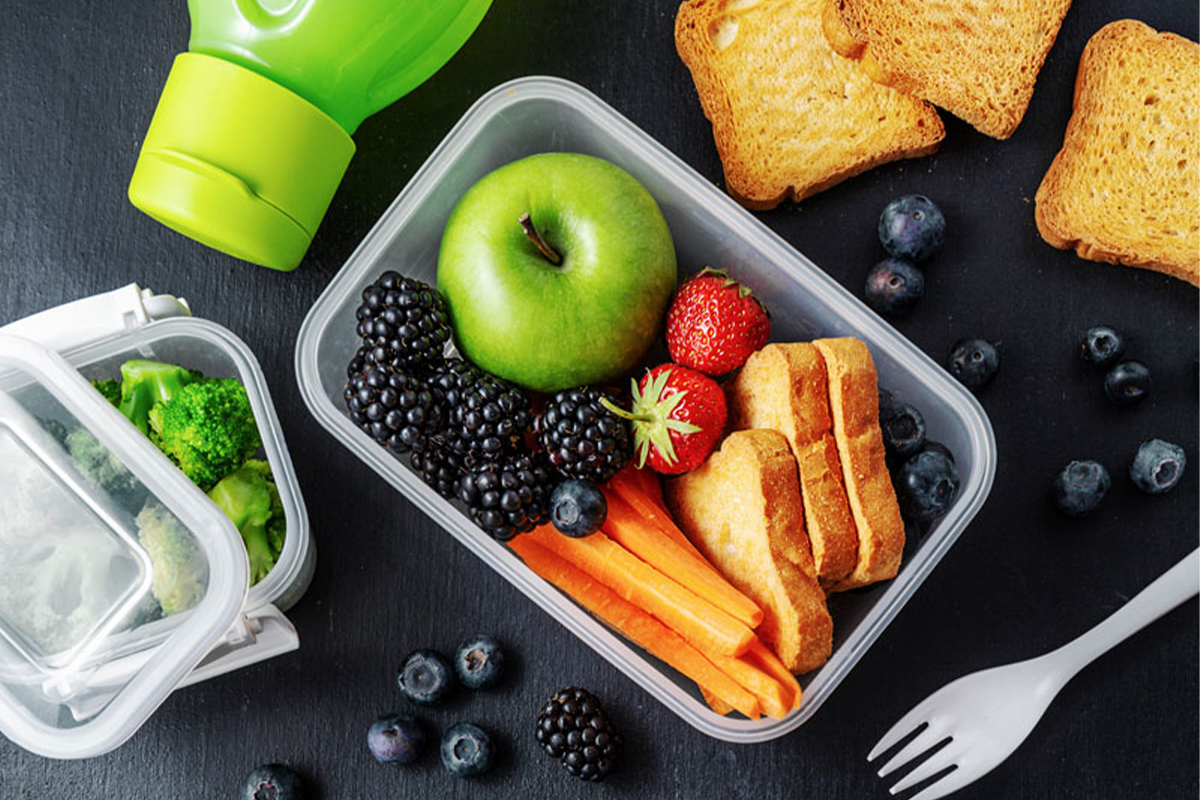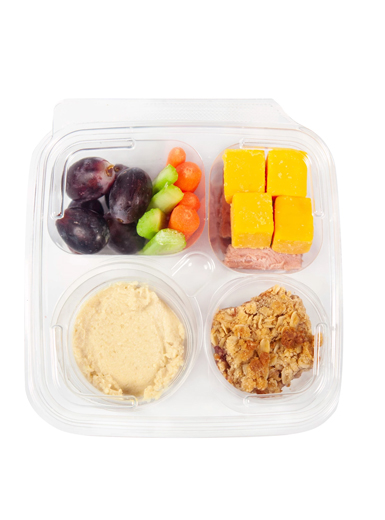How to Get Your Kids to Eat Right
If you’re a parent, it’s likely you have some picky eaters on your hands. Our Registered Dietician, Debbie James, gives you the scoop on healthy eating for your kids and teens.

We’ve all heard the outburst “I’m not hungry!” when a healthy meal is placed in front of an obviously low-fueled child. [And why, oh why, does this particularly happen after ordering an expensive dish or preparing a labor-intensive meal followed by said child eating half a loaf of bread?] Children certainly can be poor eaters, no doubt. With patience and creativity, parents can turn that into “Peas please, Mom!”
It all starts in infancy when the innate taste preference for sweet flavor (bitter foods were toxic in human history) is met with a bounty of fruity baby food; followed by edible treats from Grandma’s kitchen making their way into toddler hands. No wonder getting little ones to eat decent solid food can be challenging. It’s said that it may take 15 times of introducing a new food item before a child will eat it!
If your kiddo seems to eat the same thing day in and out, you may not need to worry. Food jags are generally okay lasting anywhere from a couple of weeks to a couple of months. Continue to offer nutritious choices and a child will eventually eat when they are hungry enough. Remember, feeding your child is about nourishment. If you engage in a battle of the wills, your child’s attitude toward food in general may lean toward the negative and his or her long-term nutrition may lose out.
Let’s talk about the elephant in the kitchen – vegetables. Children are known for eschewing them from their plates and failing to consume the recommended number of servings (see highlight/box below). Only a handful of veggies satisfy children’s preference for sweet, namely: carrot, corn, sweet potato/yam, tomato and acorn squash. We could write an entire blog just addressing ways to get your kid to eat more vegetables, but here we’ll name a few.

It may be the look. Who said they had to be served in leafy salad or in a naked cooked pile on the plate? Make it fun and appealing! Shred or spiralize vegetables to serve as a topping for sandwiches, burgers, pasta and more. Combine diced vegetables as ‘confetti’ with rice, quinoa or couscous.

Texture aversions present an opportunity to find ways of preparing foods in another manner with an acceptable mouthfeel. Slimy hot okra might be replaced by breaded okra bites. Stringy or leafy vegetables may be pureed into smoothies, soups or sauces. Freeze dried or lightly fried vegetable chips work well in lunch boxes.

Don’t forget about between meal eating. Snacks are necessary for continued energy and offer a valuable time for additional nutrients, especially for small bellies that can only get so much at mealtime. Serve beet-blended pink hummus with crackers or pita bread.

Involve Kids in Food Prep
To increase interest in food, try to get kids involved in cooking or at least preparing a few meals here and there. Children are more likely to try the fruits of their labor than if food is just presented to them. A four–year–old can scoop and stir, a six year old can pour and peel, an eight year old can measure and assemble, while a ten year old can cut and become more confident in advanced tasks. Children like to feed themselves, so finger-friendly foods assure independence at mealtime. To help promote a desire to eat, make sure kids aren’t full of empty calorie foods before meals — keep sweets and treats at a minimum.

Older children often make their own food decisions about what to buy from the school cafeteria or buy from vending machines and drive-through. There’s a reason why teens are stereotyped for their greasy fast food choices, soda and pizza consumption. In a way, adolescents are exerting their freedom from rules and parental control.
On the flip side, too much attention and focus on healthfulness of food can lead to dieting and an unhealthful preoccupation with nutrition among teenagers. Set clear expectations on how spending cash is to be used. It’s best to be a good role model, following habits and behaviors that demonstrate healthy choices, starting early when children are young.
At any stage of childhood, parents should consult with a healthcare professional if their child’s growth is no longer on trend for them individually. For specific eating behaviors and nutritional concerns, look for a Registered Dietitian who is a board–certified specialist in pediatric nutrition, designated by the CSP credential.
Recommended daily vegetable servings*
| Children | 2-3 years old | 1 cup |
| Children | 4-8 years old | 1-1.5 cups |
| Girls | 9-13 years old | 2 cups |
| Boys | 9-13 years old | 2.5 cups |
| Girls | 14-18 years old | 2.5 cups |
| Boys | 14-18 years old | 3 cups |
Cup vegetable equivalents (1 cup = 1 baseball or fist of an average adult)
| 1 cup | Tomato and other vegetable juices |
| 1 cup | Broccoli, Carrots, Green beans and other cooked chopped vegetables |
| 1 cup | Pumpkin and other winter squash |
| 1 cup | Peas, Corn and other starchy vegetables |
| 1 cup | Celery, Peppers, Cucumber and other raw crunchy vegetables |
| 2 cups | Spinach and other raw leafy greens |
*Reference: Daily Vegetable Table. USDA. www.choosemyplate.gov/vegetables July 18, 2019. Accessed 9.6.2019


I usually work out at 6 or 7 am and I want to know if it’s better to eat breakfast before or after working out. If it’s after what should I eat before working out? Thank you for your help
– Santiago C.

Optimal eating before and after a workout is all relative to the type and extent of your morning training. Some research points to greater fat burning performing cardio in a fasted state. Yet everyone seems to have a different eating schedule that works for them. Do you feel energized by a light breakfast ahead before working out or does it leave you feeling dull? Are you ravenous after working out or do you not register any hunger then?
BEFORE (approx. 30 minutes prior)
Since you don’t have the 3-4 hours ahead of time for a full meal, you can focus on a quick energy boost to restore glycogen and prime blood sugar for working muscles. If you don’t tolerate food well first thing in the morning, choose a simple carbohydrate source such as a cup of applesauce or single serving of graham crackers/pretzels with a cup of water. Move up to a mini meal of one egg plus a slice of bread and glass of milk if you feel better with solids in your system. You can also blend up a breakfast smoothie with Greek or skyr yogurt, cracked flaxseed, berries and banana.
DURING
Don’t forget about the opportunity to consume some nutrition during physical activity. For an intense exercise bout that lasts at least an hour you may consider sipping on a glucose-electrolyte beverage, aka traditional sports drink. These provide simple sugars for energy and potassium and sodium for muscle contractions and nerve impulse stimulation, as well as hydration for temperature regulation and nutrient processing.
AFTER (within 30 minutes following)
Immediately you can eat a granola-type bar you’ve packed in your locker bag or grab a protein shake from the juice bar to start off your recovery. This time is critical to nourishing your body for the whole day. Now’s the time for a heartier meal (e.g. oatmeal, lean turkey sausage and grapefruit) or a healthy breakfast wrap of eggs, spinach, feta, salsa and wheat tortilla. Choose foods with some protein and complex carbohydrate – a little fat is okay, too!
– Debbie J., MS, RD
This article should not replace any exercise program or restrictions, any dietary supplements or restrictions, or any other medical recommendations from your primary care physician. Before starting any exercise program or diet, make sure it is approved by your doctor.
Some questions have been edited for length and/or clarity.
 Have a nutrition question? Our registered dietitian is ready to help!
Have a nutrition question? Our registered dietitian is ready to help!
Email nutrition@lafitness.com or submit your question below and it may be featured in an upcoming article!
If you’re a parent, it’s likely you have some picky eaters on your hands. Our Registered Dietician, Debbie James, gives you the scoop on healthy eating for your kids and teens.
Debbie James, RDN, helps answer a reader’s question on breakfast and working out.
Debbie James, RDN, helps answer a reader’s question on introducing teens to better nutrition.


Good morning,
I have a question about how to introduce my daughter to a better way to eat. She is 17 but loves to eat junk food, no veggies. I think the way she eats is affecting her ability to concentrate and perform in school.
Please help.
– María G.

I’m glad you said ‘introduce’ instead of lecture, tell, instruct, etc. Teenagers seem to hardly listen to their parents, let alone experts, regarding self-care choices. Communication experts suggest giving praise for good decisions. Another approach is to discuss how food industry marketing overtly influences their food choices. Perhaps start a conversation by asking her what factors she thinks are impacting her school performance – then listen and act on those first.
Although I’ve a handful of websites* to suggest she visit (assuming she bothers to read them), most teens are influenced by their peers and social media. Sigh. Role modeling a healthy lifestyle is one of the best things you can do as a parent, letting you “teach by example.” Behaviors and choices surrounding a nutritious diet, adequate sleep and routine exercise should be a family undertaking. That includes siblings and other adults in the home too!
Tips
Recommended Sites:
– Debbie J., MS, RD
This article should not replace any exercise program or restrictions, any dietary supplements or restrictions, or any other medical recommendations from your primary care physician. Before starting any exercise program or diet, make sure it is approved by your doctor.
Some questions have been edited for length and/or clarity.
 Have a nutrition question? Our registered dietitian is ready to help!
Have a nutrition question? Our registered dietitian is ready to help!
Email nutrition@lafitness.com or submit your question below and it may be featured in an upcoming article!
If you’re a parent, it’s likely you have some picky eaters on your hands. Our Registered Dietician, Debbie James, gives you the scoop on healthy eating for your kids and teens.
Debbie James, RDN, helps answer a reader’s question on breakfast and working out.
Debbie James, RDN, helps answer a reader’s question on introducing teens to better nutrition.

Snacks can easily be something to grab-n-go! Whether you invest a little effort to prep snacks ahead of time or purchase one of the many available options at the grocery store, a quick snack “helps bridge the gap between meals,” as Kimberlain puts it.
It used to be that eating between meals was a “no-no.” Snack food was often equated with junk food. But no more! Eating healthy snacks in between meals can give you an energy boost, keep you satisfied and help prevent overeating at meals. The right snacks can add fiber and nutrients to your day without an abundance of calories.
Many people know this but still end up stretched thin and starving by the next meal or dragged down by fat and calories. Why? Several obstacles can stand in the way of snacking smart. We dug in with the help of Amy Kimberlain, RD, Spokesperson for the Academy of Nutrition and Dietetics in Miami, Florida, to find solutions for seven common snack problems.


Follow These 7 Solutions


01.
NO PREP TIME
Snacks can easily be something to grab-n-go! Whether you invest a little effort to prep snacks ahead of time or purchase one of the many available options at the grocery store, a quick snack “helps bridge the gap between meals,” as Kimberlain puts it. She suggests protein packs, nuts pre-portioned with dried fruit or simply a banana or apple. An individual tuna salad kit complete with crackers is another quick option. Even a package of peanut butter sandwich crackers or small 1.5 ounce energy bar works.
02.
DIETING
If you think you need to avoid snacking to curb overall intake, think again. Kimberlain comments that “going too long without eating may sometimes lead to overeating.” Crunchy fruit or vegetables provide bulk with fewer calories, such as fresh fruit bowl, celery sticks, baby carrots, sliced cucumbers, mini bell peppers, and sugar snap peas. Those are light enough to combine with a couple tablespoons yogurt dip or hummus. Items under 150 calories like these Avocado Turkey Roll Ups and Strawberry Coconut Energy Bites, as well as low-sodium V8® juice, also serve for calorie-controlled snacking.


03.
CARDIAC DIET
Sensible snack choices can be part of a heart-healthy diet! Low-saturated fat foods that have moderate protein or high fiber will satisfy between meals. Pick items with 2 or more grams of fiber per serving. Functional foods that include omega-3 fatty acids or calcium + vitamin D are also heart-smart. Our top recommendations include grapes & almonds, peach & nonfat cottage cheese, and a whole-wheat waffle with 1 Tbsp. peanut butter and a few berries. Create your own 3-ingredient trail mix with 1 cup pretzels or dry cereal, 1/4 cup raisins or other small dried fruit, and 1/4 cup cashews or pistachios; makes 4 servings.
04.
ATTACK OF THE MUNCHIES
Having a salty, crunchy snack craving can lead you to grab a not–so–healthy treat. Goodbye chips — Kimberlain states, “There are several savory foods you can purchase ahead of time and portion out at home to meet your salt cravings. This way you can grab a healthy snack to take to work, instead of grabbing something salty from the vending machine.” Find a microwave low-sodium popcorn in single-serve (usually 100 calorie) bags. Try seasoned roasted chickpeas, dry roasted seaweed sheets or freeze dried crunchy veggies. Aim for 200 mg or less total sodium per snack.


05.
MEALTIME MISHAP
When you’ve missed a meal or are running a couple hours behind, cramming in a full meal before yet another one later may do more harm than good. Mini-meals that are filling yet calorie-controlled resolve this situation. Here are some of our favorites… Half quesadilla: whole wheat tortilla with a slice of reduced fat cheese, leaves of spinach and a spoonful of salsa, folded and pan warmed. Mini pizza: grain bagel half topped with marinara sauce and shredded low fat cheese, broiled until cheese is melted. Potato bites: split 4 creamer potatoes, scored and microwaved open-faced with broccoli bits, then topped with nonfat cottage cheese and a squirt of hot sauce.
06.
DESSERT DOWNFALL
Instead of giving in to your sweet tooth’s urge for a dessert, consider healthy alternatives. Kimberlain says, “While it’s OK to indulge your cravings every now and then, there are healthier options out there that will help satisfy these cravings.” Try a slice of cinnamon toast or a few graham crackers instead of rich baked goods. Opt for flavored yogurt instead of ice cream or pudding. For a fruitier flavor, pop berries into your mouth for sweetness with each bite or mix diced apples with a couple spoonfuls light whipped cream and walnuts.


07.
NUT-FREE AND VEGETARIAN
There’s more to snacks than carb-loaded starches like pretzels for vegetarians who also need to avoid nuts. Protein helps you feel fuller longer, and meat-free protein sources are no exception. Kimberlain shares that “there are plenty of quick, nut-free snack options that pack lots of protein.” Her top suggestions are edamame, hard-boiled egg, hummus (or other bean dips), and cheese with fruit. A high protein skyr or Greek yogurt with granola is another good option, as is a sunflower seed butter + sliced banana–topped English muffin half.

Welcome to the 27th episode of the Living Healthy Podcast, presented by LA Fitness.
On this episode of the Living Healthy Podcast, we’re discussing what a plant-based diet is, how it differs from a vegetarian diet, and whether or not you should try it!
How Are We Doing?
This podcast should not replace any exercise program or restrictions, any dietary supplements or restrictions, or any other medical recommendations from your primary care physician. Before starting any exercise program or diet, make sure it is approved by your doctor.
Intro
Begins at 0:01
Introduction of LAF Registered Dietitian, Debbie James
0:38
What is The Plant-Based Diet?
1:04
Is it Different from Following a Vegetarian or Vegan Diet?
1:53
Is There a Healthier Meat You Should Lean Towards Eating When Following This Plan?
2:22
How Often Should You Include Meat in a Plant-Based Eating Plan?
2:45
What Are the Benefits of Following a Plant-Based Eating Style?
4:09
Should All the Veggies You Eat Be Organic?
5:19
Where Do Potatoes Fall into This?
6:11
Is the Plant-Based Diet for Everyone? Can Everyone Benefit from Following This Style of Eating?
7:15
Do You Have to Eat More Frequently?
8:05
Some Plant-Based Meal Suggestions
8:46
Plant-Based Meats – Are These Healthy Options?
10:36
Would Someone Following a Plant-Based Eating Style Have to Supplement?
14:57
When Can You Go for More Information?
18:42
Actionable Advice
20:23
Outro
21:10
On this episode of the LHP, we're discussing what a plant-based diet is, how it differs from a vegetarian diet, and whether or not you should try it.
Be the first to know about exclusive
content, deals and promotions